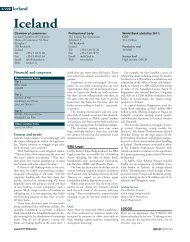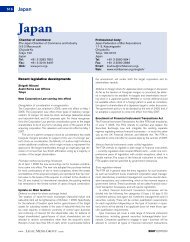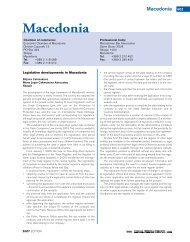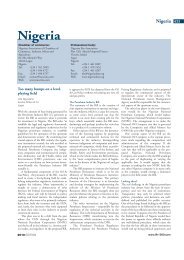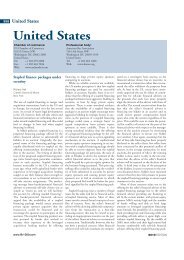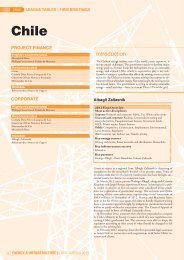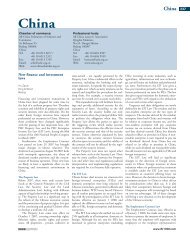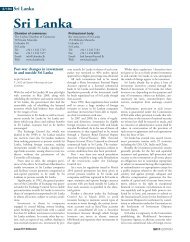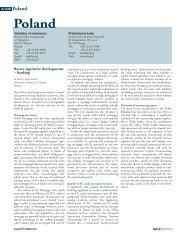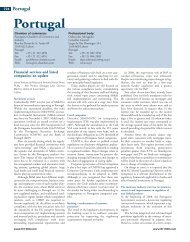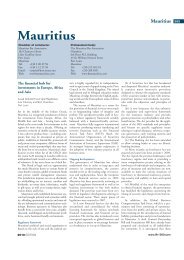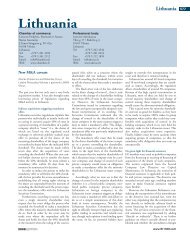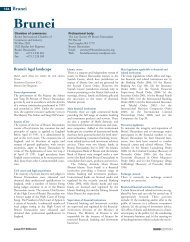Canada - IFLR1000
Canada - IFLR1000
Canada - IFLR1000
Create successful ePaper yourself
Turn your PDF publications into a flip-book with our unique Google optimized e-Paper software.
<strong>Canada</strong><br />
135<br />
<strong>Canada</strong><br />
Chamber of commerce:<br />
The Toronto Board of Trade<br />
1 First Canadian Place<br />
PO Box 60<br />
Toronto, Ontario M5X 1C1<br />
<strong>Canada</strong><br />
Tel: +1 416 366 6811<br />
Fax: +1 416 366 8406<br />
Email: info@bot.com<br />
Web: www.bot.com<br />
Professional body:<br />
The Canadian Bar Association<br />
500-865 Carling Avenue<br />
Ottawa, Ontario K1S 5S8<br />
<strong>Canada</strong><br />
Tel: +1 613 237 2925 /<br />
+1 613 237 1988<br />
Fax: +1 613 237 0185<br />
Email: info@cba.org<br />
Web: www.cba.org<br />
Developments in Canadian<br />
securities law<br />
Mark Trachuk<br />
Osler Hoskin & Harcourt<br />
Toronto<br />
The courts and securities regulators in <strong>Canada</strong><br />
have demonstrated active oversight in a<br />
volatile market with several rulings, recommendations<br />
and proposals related to stakeholder<br />
protection in the context of capital<br />
markets transactions. Also, several new practices<br />
and opportunities have emerged in<br />
response to critical tax changes and market<br />
conditions.<br />
Directors’ duty to a corporation<br />
In December 2008, the Supreme Court of<br />
<strong>Canada</strong> released reasons for its decision in<br />
BCE Inc v 1976 Debentureholders. The<br />
Court affirmed the trial judge’s approval of<br />
the directors’ business judgment that the<br />
transaction at issue was in the best interests of<br />
the corporation and did not violate the reasonable<br />
expectations of the debenture holders.<br />
The court clarified that directors need to<br />
follow proper process when exercising their<br />
business judgment and reaffirmed that the<br />
directors’ fiduciary duty is owed to the corporation<br />
and not any particular constituency,<br />
thereby rejecting the Revlon duty to maximize<br />
shareholder value in change of control transactions.<br />
TSX shareholder approval requirements<br />
In April 2009, the Ontario Securities<br />
Commission (OSC) released its reasons for its<br />
decision concerning Hudbay Minerals’ proposed<br />
acquisition of Lundin Mining through<br />
an all-stock arrangement that would have<br />
resulted in just over 100% dilution to<br />
Hudbay. In January 2009, the OSC overturned<br />
the decision of the Toronto Stock<br />
Exchange (TSX) to not require Hudbay shareholder<br />
approval of the acquisition.<br />
The OSC considered the level of dilution<br />
extreme and concluded that permitting the<br />
transaction to proceed without shareholder<br />
approval would undermine the quality of the<br />
marketplace and be contrary to the public<br />
interest. The OSC’s decision has led to considerable<br />
uncertainty about the level of dilution<br />
at which shareholder approval will be<br />
required in <strong>Canada</strong>. The TSX has responded<br />
by proposing amendments to its rules that<br />
require a listed company to obtain shareholder<br />
approval when issuing more than 50% of<br />
its shares in connection with the acquisition<br />
of another public company.<br />
Confidentiality covenants<br />
In January 2009, the Ontario Superior Court<br />
held that Research in Motion (RIM) was in<br />
breach of its confidentiality and standstill<br />
agreements with Certicom in commencing a<br />
hostile bid for Certicom and enjoined RIM<br />
from proceeding with its bid. RIM’s standstill<br />
obligations had expired six months prior to<br />
the commencement of the bid but its confidentiality<br />
obligations remained in effect. The<br />
decision will impact the negotiation of confidentiality<br />
and standstill agreements as it<br />
arguably constructs a super-standstill from the<br />
confidentiality covenant regardless of the<br />
terms of the standstill.<br />
Canadian securities regulator<br />
The Expert Panel on Securities Regulation<br />
released its report, Creating an Advantage in<br />
Global Capital Markets in January 2009. The<br />
report recommended that the federal government,<br />
co-operatively with participating<br />
provinces, establish a single national<br />
Canadian securities regulator. The federal<br />
government responded by committing several<br />
million dollars in its 2009 budget to fund the<br />
Canadian Securities Transition Office, which<br />
is charged with drafting legislation for a single<br />
national regulator.<br />
According to the panel, as systemic failures<br />
continue to manifest themselves in the capital<br />
markets, such risks must be managed on an<br />
increasingly co-ordinated global basis. From<br />
<strong>Canada</strong>’s perspective, such management can<br />
only be done properly through a single<br />
national securities regulator.<br />
Spac listings<br />
In December 2008, amendments to the TSX<br />
Company Manual permitting the listing of<br />
special purpose acquisition companies (Spacs)<br />
on the TSX came into force. Already popular<br />
in the United States for a number of years,<br />
Spacs are shell companies that raise equity to<br />
undertake a yet-to-be-determined significant<br />
acquisition no later than 18 to 36 months<br />
after their IPO. The SPAC rules are expected<br />
to obtain broad support and provide a significant<br />
new avenue for capital creation and<br />
acquisition activity in <strong>Canada</strong>.<br />
Conversion of income trusts<br />
In October 2006, <strong>Canada</strong>’s minister of finance<br />
announced that income trusts would no<br />
longer be permitted to deduct income distributions<br />
for tax purposes commencing in 2011.<br />
This means that in 2011, most trust structures<br />
will lose the superior tax efficiencies that<br />
they currently enjoy, and trusts effectively<br />
have until 2011 to either be bought or convert<br />
to a conventional corporate structure.<br />
Immediately following the announcement,<br />
there was a significant flurry of M&A activity<br />
in the trust sector; but, with the credit crunch<br />
taking hold in mid-2007, that activity slowed<br />
to a trickle during the last year. However,<br />
while still relatively modest, conversion activity<br />
has picked up and is expected to significantly<br />
accelerate as we approach 2011.<br />
Financial hardship exemption<br />
Prevailing market conditions have placed<br />
many public companies in critical need of<br />
cash. Since financing options that require<br />
shareholder approval take time and may jeopardize<br />
an issuer’s opportunity to raise capital<br />
quickly, numerous listed companies in distress<br />
have relied on the financial hardship exemption<br />
from the shareholder approval require-<br />
2010 EDITION www.iflr1000.com
136<br />
<strong>Canada</strong> | Capital markets<br />
ments otherwise prescribed by the TSX rules<br />
and Multilateral Instrument 61-101. The<br />
exemption provides relief from the requirement<br />
for valuations and shareholder approval<br />
for certain related party financings where the<br />
issuer is in serious financial difficulty.<br />
Conclusion<br />
Securities regulators in <strong>Canada</strong> have demonstrated<br />
a willingness to more actively engage<br />
in market oversight. As new capital markets<br />
structures and practices continue to emerge in<br />
response to market volatility, such active oversight<br />
is expected to continue.<br />
Capital markets<br />
Recommended firms<br />
Tier 1<br />
Davies Ward Phillips & Vineberg<br />
Osler Hoskin & Harcourt<br />
Stikeman Elliott<br />
Torys<br />
Tier 2<br />
Blake Cassels & Graydon<br />
Goodmans<br />
McCarthy Tétrault<br />
Tier 3<br />
Bennett Jones<br />
Borden Ladner Gervais<br />
Fasken Martineau<br />
Ogilvy Renault<br />
Tier 4<br />
Cassels Brock<br />
Fraser Milner Casgrain<br />
McMillan<br />
Conservative investment strategies saved<br />
much of the country’s financial community<br />
from the substantial losses suffered elsewhere<br />
in the world. “We’re not recession-proof. I<br />
think we’re recession-resistant,” is how one<br />
lawyer describes <strong>Canada</strong>’s present economic<br />
health. And while most capital markets<br />
departments in the US were starved for deal<br />
flow, Canadian firms received a lower but consistent<br />
pipeline of transactions to keep them<br />
busy.<br />
The capital markets have remained open<br />
for Canadian financial institutions and commodities<br />
issuers in particular. The defensive<br />
investments made in gold through the fall of<br />
2008, during the freefall of market paranoia,<br />
exhibits that sector’s ability to sustain activity<br />
as well. “It was not nearly as deep a recession<br />
as we feared. There was more activity in traditional<br />
areas than we might have expected,”<br />
www.iflr1000.com<br />
comments one partner. That activity does not<br />
include IPOs, however, as the Canadian market<br />
has witnessed a virtual halt in initial public<br />
offerings along with the rest of the world.<br />
Recapitalisation is the foremost concern of<br />
Canadian banks. With their lending capabilities<br />
contracting considerably in the last year,<br />
financial institutions took advantage of market<br />
appetite for common stock and mediumterm<br />
note offerings throughout the year.<br />
CIBC (Canadian Imperial Bank of<br />
Commerce), RBC (Royal Bank of <strong>Canada</strong>)<br />
and Scotiabank are only a handful of the institutions<br />
restoring their balance sheets through<br />
such transactions. But despite this flurry of<br />
activity, <strong>Canada</strong>’s financial law firms were<br />
forced to rely on a broader base of issuer<br />
clients than in the past. Several lawyers<br />
emphasised the importance of mid-market<br />
clients because of their consistent activity in<br />
any market.<br />
Risk aversion has led to the renewed popularity<br />
of the bought deal structure for issuers.<br />
Developed nearly two decades ago as what<br />
lawyers describe as a defensive tactic against<br />
foreign investment banks, the entire issuance<br />
is pre-sold to an underwriter before being<br />
marketed to syndicated investors. Offerings<br />
for Manulife Financial and the Canadian<br />
miner Cameco, two of the largest in the market<br />
this year, operated on the bought deal<br />
model. Canadian issuers operating bought<br />
deals have also led a resurgence of the MJDS<br />
(multijurisdictional disclosure system) with<br />
the US, allowing issuers to pre-emptively file<br />
for SEC approval before the transaction<br />
occurs.<br />
Davies Ward Phillips & Vineberg<br />
Capital markets work has long been a specialty<br />
at Davies Ward. The firm consistently finds<br />
a role in complex transactions inside and outside<br />
<strong>Canada</strong>, thanks to the established practices<br />
of lawyers like Shawn McReynolds,<br />
Patricia Olasker and Carol Pennycook. Their<br />
reputations for high-quality representation<br />
have afforded Davies Ward the luxury of a<br />
sprawling client base that ranges from institutional<br />
clients to insurance providers to commodities<br />
companies. “I think they’re a fabulous<br />
firm. Pure excellence. I rank them as one<br />
of the best firms I’ve ever run across. They<br />
have a good operating model with a high ratio<br />
of partners,” says a client.<br />
Even in years of decreased activity you can<br />
expect to see the firm’s fingerprint at the top<br />
end of the market – like its representation of<br />
ING Group in that company’s C$2.16 billion<br />
($1.9 billion) secondary offering. The offering<br />
was staged to shed ING Group’s 70% stake in<br />
ING <strong>Canada</strong> through a syndicate of underwriters<br />
including CIBC and TD Securities. A<br />
simultaneous private placement was executed<br />
through lead co-agents CIBC World Markets<br />
and Goldman Sachs to complete the sale of<br />
ING’s stake.<br />
A public offering for Rogers<br />
Communications found the firm again acting<br />
for the issuer in August 2008. Offered in the<br />
US, the two-tiered issuance of debt securities<br />
consisted of $1.4 billion in ten-year notes and<br />
an additional $350 million in 30-year notes.<br />
Davies Ward served as Canadian counsel in<br />
the $1.75 billion transaction.<br />
Davies Ward has also made inroads in the<br />
infrastructure sector of late. Mandates<br />
through the firm’s project finance platform<br />
have also resulted in follow-on work for the<br />
capital markets department this year. Carol<br />
Pennycook and Sonny Bhalla advised<br />
Infrastructure Ontario in a $300 million private<br />
placement of bonds due in 2013 to a syndicate<br />
led by TD Securities. Funds raised<br />
through the sale will go towards public infrastructure<br />
development projects throughout<br />
Ontario.<br />
Leading lawyers<br />
Shawn McReynolds<br />
Patricia Olasker<br />
Carol Pennycook<br />
Osler Hoskin & Harcourt<br />
The broader corporate practice at Osler offers<br />
a carryover of issuer and underwriting work<br />
for the firm’s capital markets group.<br />
Longstanding institutional clients like the<br />
BMO (Bank of Montreal) and RBC are combined<br />
with the diversity of issuer-side clients<br />
such as mining companies Cameco and<br />
Kinross Gold Corporation. When asked<br />
about Osler’s standing in the market, one peer<br />
remarks: “I absolutely think Osler is a top-tier<br />
firm without a doubt.” Several peers also recommend<br />
the counsel of John Macfarlane and<br />
Desmond Lee, denoting the two as clear leaders<br />
of the practice.<br />
Operating in tandem between its Toronto<br />
and New York offices, Osler advised Cameco<br />
in its issuance of nearly 30,000 common<br />
shares in March 2009. Sold in a bought deal<br />
to a syndicate led by BMO Nesbitt Burns and<br />
RBC Dominion Securities, Cameco was able<br />
to sell an additional 3,400 shares through the<br />
exercise of an over-allotment option in the<br />
underwriting agreement. All told, the offering<br />
raised $460 million for Cameco.<br />
Osler also showed its expertise in the highyield<br />
market this year by representing the syndicate<br />
of underwriters for the $1.75 billion<br />
note offering by Rogers Communications.<br />
The public offering was issued in two tranches<br />
of ten-year 6.8% notes and 30-year 7.5%<br />
notes. The cross-border nature of the offering<br />
2010 EDITION
Capital markets | <strong>Canada</strong><br />
137<br />
also exhibited Osler’s abilities to navigate the<br />
MJDS (multijurisdictional disclosure system)<br />
agreement with the US.<br />
Leading lawyers<br />
Desmond Lee<br />
John Macfarlane<br />
Stikeman Elliott<br />
The overall strength of Stikeman Elliott’s corporate<br />
group, particularly in the areas of banking<br />
and M&A, has brought the firm a broad<br />
swath of issuer and underwriting representations.<br />
Another year under the direction of<br />
Mihkel Voore as co-chair of the firm’s securities<br />
law group and head of corporate finance in<br />
Toronto has proved a seamless continuation of<br />
the firm’s capital markets work.<br />
Stikeman Elliott served as Canadian counsel<br />
to returning client Trans<strong>Canada</strong> Corporation<br />
and its subsidiary, Trans<strong>Canada</strong> Pipelines, in<br />
three separate cross-border debt and equity<br />
offerings from August 2008 through January<br />
2009. Stikeman lawyers have quickly become<br />
experts at the use of the MJDS (multijurisdictional<br />
disclosure system) system to access capital<br />
markets in the US and applied that expertise in<br />
the transactions. Securing pre-approval for<br />
issuances in the US through MJDS, the firm<br />
issued debt securities for $1.5 billion and $2 billion<br />
for Trans<strong>Canada</strong> Pipelines. An equity<br />
issuance of common shares equalling $1.16 billion<br />
was also executed through the same MJDS<br />
process in November 2008.<br />
Stikeman Elliott also scored roles advising<br />
underwriting syndicates in two of the biggest<br />
offerings this year. First, in the largest share<br />
issuance by a domestic bank through 2008, the<br />
firm represented a syndicate led by RBC<br />
Dominion Securities for the $2.3 billion issue<br />
of common stock by RBC. Stikeman Elliott<br />
then advised the underwriters and agents running<br />
the syndicate for ING <strong>Canada</strong>’s $2.16 billion<br />
secondary offering and private placement<br />
in February 2009.<br />
Leading lawyers<br />
Marc Barbeau<br />
Neville McClure<br />
Christopher Nixon<br />
Jeffrey Singer<br />
Mihkel Voore<br />
Torys<br />
The capital markets team at Torys has undergone<br />
a reshuffling of senior talent in the last<br />
year. The departure of Geoffrey Creighton to<br />
IMG Financial Group was offset by the hiring<br />
of two Ogilvy Renault partners, Charles<br />
Keizer and Valerie Helbronner, as well as by<br />
the addition of Daniel Raglan. But for all the<br />
movement of personnel, Torys maintained its<br />
top-tier ranking for another year through<br />
strong issuer representations like Manulife<br />
Financial and Eagle Credit Card Trust, in<br />
addition to performances for its standard list<br />
of underwriting clients.<br />
Manulife Financial hired Torys as issuer’s<br />
counsel to engineer the issuance and private<br />
placement of C$2.3 billion ($2.1 billion) in<br />
common shares. The syndicate underwriting<br />
the transaction included all Big Six Canadian<br />
banks. Similarly, Eagle Credit Card Trust<br />
retained the firm to develop and initiate its<br />
recent C$1.5 billion note programme. Torys<br />
designed the issuance to draw its value from a<br />
pool of credit card receivables co-owned by<br />
Eagle and President’s Choice Bank.<br />
Underwriting representations for Torys<br />
included the syndicate for Scotiabank’s C$1<br />
billion domestic debt offering in April 2009.<br />
Following their sale to a syndicate that included<br />
Scotia Capital, TD Securities, RBC<br />
Dominion Securities, HSBC Securities and<br />
Merrill Lynch <strong>Canada</strong>, proceeds from the tenyear<br />
notes were used to bolster the bank’s Tier<br />
2 capital.<br />
“They’ve endeavoured to stay in touch.<br />
They’re responsive. They’re a large firm that<br />
does have a presence in the US and can leverage<br />
that when required,” says a client. “Of the<br />
Canadian firms, they are better at trying to<br />
identify business opportunities.”<br />
Leading lawyers<br />
Kevin Morris<br />
Karrin Powys-Lybbe<br />
Blake Cassels & Graydon<br />
A strong lending practice benefits the capital<br />
markets partners at Blakes through a host of<br />
financial institutions already familiar with the<br />
firm. One peer says that “Blakes has traditionally<br />
had a strong relationship with CIBC<br />
(Canadian Imperial Bank of Commerce),”<br />
going on to note the increasing quality of the<br />
work that the firm has turned out.<br />
In March 2009, Blakes represented CIBC<br />
Capital Trust as the issuer of $1.6 billion in<br />
debt. The transaction was aimed at reinforcing<br />
the bank’s Tier 1 capital. “I’ve been using<br />
them for probably five years ... primarily for<br />
securities-related work. I think they’re very<br />
responsive, very creative,” says a client.<br />
Blakes advised the underwriters for the<br />
C$511 million ($464 million) cross-border<br />
equity offering by Canadian Pacific Railway.<br />
Included in the syndicate were Scotia Capital,<br />
RBC Dominion Securities and Morgan<br />
Stanley of <strong>Canada</strong>. The firm also served as<br />
Canadian counsel to Bank of America on its<br />
$10 billion common stock issuance in<br />
October 2008.<br />
Another mandate for Blakes was representing<br />
CIBC World Markets as co-leader with<br />
Goldman Sachs <strong>Canada</strong> of an underwriting<br />
syndicate for an equity offering for Pan-<br />
American Silver Corp. The February 2009<br />
common share issuance raised $103 million<br />
for the mining company. One client singles<br />
out Ernest McNee for his talents, saying: “I<br />
find him very effective and very responsive.”<br />
Leading lawyers<br />
Frank Arnone<br />
Pat Finnerty<br />
Brock Gibson<br />
Ernest McNee<br />
Peter O’Callaghan<br />
Goodmans<br />
Goodmans maintains a reputation for quality<br />
capital markets work despite its smaller size<br />
when compared to rivals. Much of this reputation<br />
can be attributed to the senior talent<br />
the firm has amassed over the years. Stephen<br />
Halperin and Jonathan Lampe, co-heads of<br />
the firm’s corporate and securities group,<br />
along with Stephen Pincus who handles REIT<br />
(real estate investment trust) work, receive<br />
high praise from competitors.<br />
In February 2009, Lampe and Neill May<br />
were hired by Newmont Mining for a dual<br />
offering of debt and equity worth $1.7 billion.<br />
Issuing common stock and convertible senior<br />
notes due in 2012, Newmont’s fresh capital<br />
allowed the mining company to finance its<br />
acquisition of the AngloGold Ashanti stake in<br />
the Boddington mine of Australia.<br />
When Omers Realty announced its<br />
upcoming issuance of AAA debt in May<br />
2008, Goodmans was hired to advise the syndicate<br />
of underwriters and agents for the<br />
transaction. The private placement was executed<br />
in two stages, classifying $400 million<br />
of Series C notes and $200 million of Series D<br />
notes that were subsequently sold to the RBC<br />
Dominion Securities-led investor group.<br />
Leading lawyers<br />
Stephen Halperin<br />
Jonathan Lampe<br />
Neill May<br />
Stephen Pincus<br />
McCarthy Tétrault<br />
The close relationships established between<br />
McCarthy Tétrault and its Canadian lending<br />
clients allow for a high amount of crossover<br />
work in the capital markets. The close-knit<br />
structure of the corporate finance group also<br />
gives added benefit to clients through a group of<br />
partners knowledgeable across varying transaction<br />
types and practices. This model of organi-<br />
2010 EDITION www.iflr1000.com
138<br />
<strong>Canada</strong> | Banking<br />
sation simplifies transaction teams and decreases<br />
the ever-important costs of staffing a file. The<br />
work produced by the model speaks for itself.<br />
Representing a syndicate consisting of RBC<br />
(Royal Bank of <strong>Canada</strong>), TD Bank (Toronto-<br />
Dominion Bank), Scotiabank, BMO (Bank of<br />
Montreal), CIBC (Canadian Imperial Bank of<br />
Commerce) and National Bank of <strong>Canada</strong>,<br />
McCarthy negotiated the underwriting agreements<br />
behind Manulife Financial’s December<br />
2008 equity offering. Executed as a bought<br />
deal, the public offering raised $1 billion in tandem<br />
with a simultaneous $1.1 billion through a<br />
separate private placement. McCarthy also<br />
arranged $3 billion in lending facilities through<br />
the same syndicate for Manulife.<br />
As issuers’ counsel, McCarthy represented<br />
TD Bank in September 2008. Through the<br />
TD Capital Trust III, McCarthy engineered<br />
the issue of $1 billion in securities. Later in<br />
the year, the firm advised BMO in a highyield<br />
issuance worth C$450 million. Due in<br />
2017, the notes provided Tier 1 capital for the<br />
bank at the height of the economic downturn.<br />
Leading lawyers<br />
Richard Balfour<br />
Jean Michel Deschamps<br />
Byran Gibson<br />
J Michael McIntosh<br />
Robert Metcalfe<br />
Barry Ryan<br />
For analysis of the other leading law firms in<br />
<strong>Canada</strong>’s capital markets please visit the<br />
website at www.iflr1000.com<br />
Bank lending<br />
Recommended firms<br />
Tier 1<br />
Blake Cassels & Graydon<br />
McCarthy Tétrault<br />
Osler Hoskin & Harcourt<br />
Tier 2<br />
Davies Ward Phillips & Vineberg<br />
Goodmans<br />
Stikeman Elliott<br />
Tier 3<br />
Bennett Jones<br />
Borden Ladner Gervais<br />
Fasken Martineau<br />
Ogilvy Renault<br />
Torys<br />
Tier 4<br />
Burnet Duckworth & Palmer<br />
Fraser Milner Casgrain<br />
Macleod Dixon<br />
McMillan<br />
www.iflr1000.com<br />
Financial services regulatory<br />
Recommended firms<br />
Tier 1<br />
Blake Cassels & Graydon<br />
McCarthy Tétrault<br />
Osler Hoskin & Harcourt<br />
Torys<br />
Tier 2<br />
Fasken Martineau<br />
Ogilvy Renault<br />
Stikeman Elliott<br />
Tier 3<br />
Borden Ladner Gervais<br />
Fraser Milner Casgrain<br />
Goodmans<br />
The absence of subprime mortgage investment<br />
exposures and a history of conservative<br />
management have saved many Canadian<br />
financial institutions from the losses suffered<br />
in the US. But the contagions of fear and misperception<br />
still pose a hurdle, even in <strong>Canada</strong>.<br />
While transactional work has suffered, the<br />
need for regulatory advice remains consistent<br />
in the jurisdiction. “Banking has actually been<br />
a bright spot. Transactions are off across the<br />
board, but, fortunately, Canadian banks are<br />
relatively strong and can be acquirers,” says a<br />
partner. Following a flurry of recapitalisation<br />
transactions in the capital markets, many<br />
Canadian financial institutions now find<br />
themselves in an advantageous position. The<br />
question now is whether they will alter the<br />
business model that has prevented loss in<br />
order to improve post-recession market share.<br />
Banking and finance partners in <strong>Canada</strong><br />
say they began noting the pullback of foreign<br />
financial institutions from the US and Europe<br />
as early as the spring of 2008. The speculation<br />
then, much as it is now, is whether <strong>Canada</strong>’s<br />
prominent investment banks and insurance<br />
companies will try to fill the void. “Who<br />
knows, it may be the rebound of the investment<br />
banks in <strong>Canada</strong>,” says one partner.<br />
“What we’ve seen previously is a gradual erosion<br />
of the Canadian investment banks to<br />
large American banks like JPMorgan, Bank of<br />
America, and Citi. Maybe since those guys are<br />
hiccupping at the moment, we’ll see the<br />
Canadian investment banks re-establish<br />
themselves.”<br />
This potential re-development of the<br />
domestic financial sector is already causing<br />
some ripples in the legal community as well.<br />
As the banks examine the events of the past<br />
year, and the legal advice they received, some<br />
Canadian counsel see a shake-up of the historic<br />
relationships that have come to define<br />
some firm’s finance departments.<br />
The prospect of any regulatory change in<br />
<strong>Canada</strong> is doubtful thanks to the financial sector’s<br />
limited subprime exposure. In fact, many<br />
see the Canadian system as a working model<br />
for the regulatory overhauls under discussion<br />
elsewhere in the world. This has allowed<br />
lawyers here a tempered optimism as firms<br />
find their corporate departments posting better-than-expected<br />
results through early 2009.<br />
“We essentially have been busier than ever in<br />
financial services, mainly because our clients<br />
and all the banks and insurance companies<br />
have been busy building capital,” says a partner.<br />
Blake Cassels & Graydon<br />
Blakes has engineered an enviable banking<br />
group, with a strong team that includes Kevin<br />
Fougere, Michael Harquail, Dawn Jetten and<br />
senior counsel James Christie. “I use Blakes<br />
exclusively,” says a client. “I use them for securities<br />
work and they’re very effective for that.”<br />
The firm’s client list includes a mix of foreign<br />
and domestic financial institutions, such as<br />
JPMorgan and the CIBC (Canadian Imperial<br />
Bank of Commerce).<br />
In fact, JPMorgan recently sought Blakes’<br />
counsel in connection with their involvement<br />
in Teck Cominco’s acquisition of the Fording<br />
Canadian Coal Trust. Representing a syndicate<br />
led by JPMorgan, Blakes was able to construct<br />
a $4 billion senior term loan facility and<br />
a $5.8 billion senior bridge facility as part of<br />
an overall $14 billion financing package. The<br />
transaction was closed in October 2008.<br />
As part of the simultaneous rights offering<br />
and private placement of debentures for<br />
TimberWest Forest Corp, Blakes advised the<br />
arranger and syndicate negotiating changes to<br />
the issuer’s underlying credit facilities. Under<br />
Blakes’ counsel, the BMO Capital Markets<br />
and Rabobank Nederland-led syndicate<br />
amended TimberWest’s existing loan agreements,<br />
including the instalment of a new<br />
$250 million three-year revolving credit facility.<br />
Again in the forestry sector, the firm<br />
advised borrower Ainsworth Lumber on a<br />
recapitalisation programme in which Blakes<br />
negotiated the exchange of $824 million in<br />
debt for equity and $150 million in new unsecured<br />
notes. A new series of notes was also<br />
issued, equalling $200 million, and three<br />
credit facilities of equal worth were amended.<br />
Leading lawyers<br />
James Christie<br />
Martin Fingerhut<br />
Kevin Fougere<br />
Dan Fournier<br />
Michael Harquail<br />
Dawn Jetten<br />
2010 EDITION
Mergers and acquisitions | <strong>Canada</strong><br />
139<br />
McCarthy Tétrault<br />
McCarthy Tétrault is defined by its banking<br />
practice. Strong relationships with banks like<br />
BMO (Bank of Montreal), CIBC and<br />
Scotiabank give the firm a consistently dominant<br />
presence in the market. The fact that<br />
McCarthy represented BMO, CIBC, RBC<br />
(Royal Bank of <strong>Canada</strong>), Scotiabank and TD<br />
Bank (Toronto-Dominion Bank) through the<br />
restructuring of the asset-backed commercial<br />
paper (ABCP) market speaks volumes for its<br />
reputation. And given its strong track record<br />
with borrowers and lenders, it’s unsurprising<br />
McCarthy has been able to use its banking<br />
practice as a springboard for an equally reputable<br />
platform in project finance work. Barry<br />
Ryan is consistently mentioned by peers as the<br />
standout lawyer of the practice.<br />
McCarthy has made a practice out of representing<br />
syndicates of <strong>Canada</strong>’s financial institutions.<br />
Following a $2 billion equity offering by<br />
insurance provider Manulife Financial in<br />
which the firm represented a syndicate of<br />
underwriters including RBC, TD Bank,<br />
Scotiabank, BMO, CIBC and National Bank<br />
of <strong>Canada</strong>, McCarthy then negotiated the<br />
terms for a $3 billion 5-year term loan on<br />
behalf of the Big Six Canadian banks.<br />
In December 2008, McCarthy also advised<br />
BMO Nesbitt Burns and a syndicate of underwriters<br />
in separate debt and equity offerings for<br />
various investment arms of BMO. The first was<br />
a C$450 million ($408 million) issuance by<br />
BMO Capital Trust II in the form of Tier 1<br />
notes due in 2017. A second offering, this time<br />
by BMO of common shares, was executed days<br />
later, with the 33 million shares earning C$1<br />
billion for the bank.<br />
Leading lawyers<br />
Jean Michel Deschamps<br />
Byran Gibson<br />
J Michael McIntosh<br />
Robert Metcalfe<br />
Barry Ryan<br />
Osler Hoskin & Harcourt<br />
Peers offer praise of Osler’s corporate abilities,<br />
a strong reputation that also extends to the<br />
firm’s banking and regulatory groups. A longstanding<br />
relationship with RBC (the Royal<br />
Bank of <strong>Canada</strong>) benefits Osler across practice<br />
areas, and peers view the cultivation of that<br />
relationship by Michael Matheson as one of<br />
the keys to the firm’s continued success. For<br />
regulatory matters, clients and peers recommend<br />
John Jason as the firm’s star practitioner.<br />
“John Jason is the one that I work with<br />
almost all of the time. He’s very thorough,”<br />
says a client.<br />
From April 2009, Jason and Stephen<br />
Sigurdson have been retained by BMO’s lifeinsurance<br />
arm, BMO Life. The two are handling<br />
regulatory matters associated with BMO<br />
Life’s acquisition of AIG’s (the American<br />
International Group) Canadian life-insurance<br />
division – a deal estimated in value at $375 million.<br />
Also, in May 2008, Osler handled<br />
Canadian regulatory matters for JPMorgan in<br />
connection with the investment bank’s acquisition<br />
of Bear Stearns.<br />
The Osler banking team’s diversity of capabilities<br />
earns recognition from clients. “I inherited<br />
them as a firm doing work for my company,<br />
and I’ve been very happy with them,” says<br />
one. “We started a new entity in <strong>Canada</strong> and<br />
they were instrumental in getting that done.<br />
And we added a new product to an existing<br />
company and they’re assisting us on that type of<br />
thing as well. We actually use a number of<br />
firms, but I would say they are our biggest vendor<br />
in terms of the range of work we’re involved<br />
in.”<br />
Leading lawyers<br />
Richard Fullerton<br />
John Jason<br />
Etienne Massicotte<br />
Michael Matheson<br />
Frank Turner<br />
Stikeman Elliott<br />
The lawyers at Stikeman Elliott have built a<br />
diverse corporate practice that makes them<br />
competitive across the board. Clients of the<br />
M&A group return for counsel in capital markets<br />
and banking matters. This cultivation of<br />
longstanding relationships is evident in the<br />
feedback received from Stikeman clients. “We<br />
use them for all our general corporate transactions<br />
in <strong>Canada</strong>. They’re basically our lead<br />
counsel [there],” says a client. “I recommend<br />
them for everything. In particular, their assistance<br />
for transactions has been phenomenal.<br />
We wouldn’t get business done without them.<br />
They’re that good.”<br />
In connection with Jubilant Organosys’<br />
acquisition of Draxis Health, Stikeman<br />
advised the ICICI Bank <strong>Canada</strong> as lead<br />
arranger and lender. The $255 million acquisition<br />
finance package was the first executed<br />
by ICICI since its move into the Canadian<br />
market from its native India. Stikeman also<br />
advised ABN Amro as lender in the acquisition<br />
of Ipsco’s Canadian pipeline manufacturing<br />
business by the Evraz Group. The $575<br />
million financing was finalised in June 2008,<br />
allowing the Russian miner and steel manufacturer<br />
to consolidate its Canadian holdings.<br />
Leading lawyers<br />
Michael Allen<br />
Jean Lamothe<br />
Daphne MacKenzie<br />
Torys<br />
The return of Torys to the first tier in regulatory<br />
work reflects the market’s regard for Blair<br />
Keefe. Along with Sunny Sodhi, Keefe is<br />
advising the Home Equity Income Trust in<br />
regulatory aspects of its conversion to a corporation.<br />
As a result of an Ontario Superior<br />
Court ruling that ordered the conversion, the<br />
trust has restructured into a publicly-traded<br />
corporation in <strong>Canada</strong>. This process includes<br />
the removal of existing units held in the trust<br />
and their conversion to public shares, allowing<br />
the trust to emerge as a public bank under<br />
the name HomEquity Bank.<br />
In lending work, Torys advised Manulife<br />
Financial as the borrower of a five-year term<br />
loan totalling C$3 billion ($2.7 billion).<br />
Torys negotiated the facility with a syndicate<br />
of banks including CIBC, RBC, Scotiabank,<br />
BMO, National Bank of <strong>Canada</strong> and<br />
Toronto-Dominion Bank. The firm also<br />
advised AV Minerals in refinancing an existing<br />
$3 billion bridge facility with ABN Amro,<br />
Bank of America, and Citibank. The refinancing<br />
was achieved through a rights offering by<br />
the mining company in tandem with the<br />
establishment of a new $982 million term<br />
credit facility.<br />
Leading lawyers<br />
Adam Delean<br />
Michael Feldman<br />
Blair Keefe<br />
Jonathan Weisz<br />
For analysis of the other leading law firms in<br />
<strong>Canada</strong>’s bank lending and financial services<br />
regulatory market please visit the website at<br />
www.iflr1000.com<br />
Mergers and acquisitions<br />
Recommended firms<br />
Tier 1<br />
Blake Cassels & Graydon<br />
Davies Ward Phillips & Vineberg<br />
Goodmans<br />
Osler Hoskin & Harcourt<br />
Stikeman Elliott<br />
Tier 2<br />
Bennett Jones<br />
McCarthy Tétrault<br />
Ogilvy Renault<br />
Torys<br />
Tier 3<br />
Borden Ladner Gervais<br />
Burnet Duckworth & Palmer<br />
Fasken Martineau<br />
Fraser Milner Casgrain<br />
Macleod Dixon<br />
2010 EDITION www.iflr1000.com
140<br />
<strong>Canada</strong> | Mergers and acquisitions<br />
The Canadian M&A market witnessed a<br />
reduction in deal volumes last year similar to<br />
those seen in 2002-2003. Hostile market conditions<br />
allowed for few of the headline-grabbing<br />
deals seen in previous years and unravelled<br />
some of those that did make it to market.<br />
For many Canadian lawyers, the failed<br />
privatisation of BCE (Bell <strong>Canada</strong><br />
Enterprises) signalled not only an end to<br />
years-long negotiations, but to the era of<br />
leveraged buyouts as a whole. The transaction<br />
was abandoned after an audit revealed that the<br />
$41 billion buyout was no longer an acceptable<br />
financial risk for the company.<br />
Restricted lending and poor debt spreads<br />
resulting from the credit crisis have forced<br />
<strong>Canada</strong>’s private-equity investors to retreat<br />
from their previous binge of leveraged buyouts.<br />
“It’s a very different climate than it was<br />
18 months ago, when you had private equity<br />
still enormously active,” says a partner. “The<br />
pension funds in <strong>Canada</strong> have suffered.<br />
They’ve got lots of problems to manage. We’re<br />
not seeing them provoke M&A situations.”<br />
The scarcity of financing has ultimately<br />
forced deal activity into the mid-market, producing<br />
the double-edged sword of sustained<br />
deal volume with lower overall values. “The<br />
pattern in <strong>Canada</strong> is there are still a lot of<br />
deals happening but it’s the size that’s fallen<br />
off,” says one partner. “There are some significant<br />
transactions that have happened, but the<br />
over-$1 billion deals you can count on the fingers<br />
of one hand.”<br />
According to lawyers here, this sudden<br />
focus on the mid-market has strained the<br />
bench strength of Canadian firms, favouring<br />
those with a stable of talent beyond their<br />
high-profile partners. Going forward, the ability<br />
to broadly staff lower-value files is seen as<br />
an area of growth for firms.<br />
Diminished stock prices have created<br />
marked dislocation between buyers and sellers,<br />
halting most deals in their preliminary<br />
stages. “That’s the biggest problem right now.<br />
It’s weird because other than AIG and people<br />
you would suspect would be sellers, the sellers<br />
are not so pushed that they’re lowering their<br />
prices. And the buyers aren’t going to pay<br />
those prices.” The gridlock has left most deals<br />
to wither on the vine as sellers come to terms<br />
with the valuations of the new, post-recession,<br />
reality.<br />
Blake Cassels & Graydon<br />
Blakes breaks into the first tier after a round of<br />
strong peer feedback concerning the firm’s<br />
commitment to quality in its M&A work.<br />
“They’ve been on an upward trend in number<br />
of deals and deal value over the past five<br />
years,” says one peer.<br />
www.iflr1000.com<br />
With equally respected banking and<br />
finance platforms, the subsequent rise of<br />
Blakes’ M&A practice in the rankings exhibits<br />
the firm’s full-service strategy across practice<br />
areas and geography. One detail that doesn’t<br />
escape the recognition of Blakes’ peers is its<br />
presence in every province of <strong>Canada</strong> and its<br />
ability to staff cross-border files through<br />
offices in New York, Chicago, London and<br />
Beijing. With particular strength in the western<br />
Canadian provinces, energy and mining<br />
are strong focuses for the group.<br />
Brock Gibson is credited by peers as having<br />
given the M&A group at Blakes a resurgence<br />
as of late. Elected chairman of the firm<br />
in January 2009, Gibson is leading the<br />
response for Suncor Energy in its proposed<br />
merger with Petro-<strong>Canada</strong>, potentially the<br />
largest oil and gas transaction in <strong>Canada</strong> since<br />
2006. The $38.5 billion merger of rivals will<br />
create the largest Canadian energy company<br />
through a weighted share exchange that gives<br />
Suncor 60% ownership and Petro-<strong>Canada</strong><br />
40% in the new company. The exchange and<br />
subsequent ownership percentages were determined<br />
by the existing pre-merger share prices<br />
of each company.<br />
Elsewhere in the energy sector, Blakes<br />
advised Nexen when the oil services company<br />
acquired an additional 15% interest in the<br />
Long Lake oil sands project from Opti<br />
<strong>Canada</strong>. Closing in January 2009, the $735<br />
million transaction gives Nexen an overall<br />
stake of 65%.<br />
Leading lawyers<br />
Frank Arnone<br />
Pat Finnerty<br />
Brock Gibson<br />
Graham Smith<br />
Davies Ward Phillips & Vineberg<br />
While megadeals have disappeared from the<br />
market, the expertise harboured at Davies<br />
Ward has not. Peers still regard the firm’s<br />
M&A group as one of the most capable in<br />
<strong>Canada</strong>. Offering offices in Toronto,<br />
Montreal and New York, the firm has long<br />
focused on the types of transactions symbolised<br />
by their representation of BCE in the<br />
proposed privatisation of the Canadian telecoms<br />
company.<br />
Even with the proposal of the largest buyout<br />
in history occupying the firm, Davies<br />
Ward managed to take on a host of other<br />
complex matters. In September 2008, the<br />
firm advised the special committee of the<br />
board at Rothmans in its $2 billion acquisition<br />
by rival Philip Morris. May 2008 saw the<br />
firm represent the parent for the Toronto<br />
Stock Exchange, TSX Group, in its merger<br />
with the Montreal Exchange to create the<br />
TMX Group. The deal included issuance of<br />
15.32 million shares and $1.1 billion in cash<br />
paid to shareholders of the Montreal<br />
Exchange.<br />
“As far as I’m concerned, from an M&A<br />
perspective, they’ve got the best guys on the<br />
street,” says a client. “For takeover bids, which<br />
is our business, they are great. They know the<br />
statutes, all the rules. And from the practical<br />
side, their legal advice is a dose of practical<br />
reality – what you can get done in the circumstances<br />
– which I think separates them<br />
from everyone else in town. One other thing I<br />
like is they use very small teams and you’re<br />
only dealing with one or two guys over there<br />
at one time.”<br />
Leading lawyers<br />
William Ainley<br />
Maryse Bertrand<br />
William Gula<br />
Kenneth Klassen<br />
Kevin Thomson<br />
Goodmans<br />
Goodmans has the ability to consistently<br />
appear on high-profile transactions – even<br />
with one of the smaller M&A groups in<br />
<strong>Canada</strong> and a single office, located in<br />
Toronto. “They punch above their weight,”<br />
comments one peer. And while rivals debate<br />
whether this setup is optimal for the long<br />
term in comparison to larger, more geographically<br />
diverse firms, few can deny the market<br />
presence Goodmans has been able to establish<br />
in recent years.<br />
The perennial talents of Stephen Halperin<br />
and Jonathan Lampe are highlighted by peers<br />
with regard to deal execution for clients.<br />
Through 2008, Lampe led the firm’s representation<br />
of the acquiring parties in the BCE<br />
buyout, including the Ontario Teachers<br />
Pension Plan and Madison Dearborn<br />
Partners.<br />
The firm engineered two simultaneous<br />
offerings of common stock and convertible<br />
senior notes for Newmont Mining<br />
Corporation as financing for an acquisition in<br />
February 2009. With $1.1 billion in fresh<br />
capital from the offerings in place, Goodmans<br />
then advised Newmont on its purchase of the<br />
remaining interest in the Boddington project<br />
from AngloGold Ashanti of Australia. To<br />
date, Boddington is the largest active gold<br />
mine in the world.<br />
Goodmans is also counselling Deutsche<br />
Bank and RBC Capital Markets as the financial<br />
advisors to Petro-<strong>Canada</strong> for that company’s<br />
proposed merger with Suncor Energy.<br />
With a combined value of $38.5 billion, the<br />
merger of oil and gas rivals will create<br />
<strong>Canada</strong>’s largest energy company.<br />
2010 EDITION
Mergers and acquisitions | <strong>Canada</strong><br />
141<br />
Leading lawyers<br />
Stephen Halperin<br />
Jonathan Lampe<br />
Dale Lastman<br />
Neill May<br />
Osler Hoskin & Harcourt<br />
Economic downturns produce their own<br />
stratification in terms of which law firms are<br />
in demand, and Osler hasn’t missed a step.<br />
“Osler is always a force to be reckoned with,”<br />
remarks one peer of the firm’s M&A practice.<br />
Representations like advising long-time client<br />
RBC (Royal Bank of <strong>Canada</strong>) in the $2.2 billion<br />
acquisition of the Royal Bank of Trinidad<br />
and Tobago have reinforced Osler’s reputation<br />
for cross-border expertise. Fifteen years with<br />
an established New York office stands as further<br />
proof.<br />
Osler’s strength is ultimately in its breadth<br />
of representations, a carryover benefit of having<br />
one of the leading corporate departments<br />
in <strong>Canada</strong>. “They were our corporate counsel<br />
and we’ve used them extensively – not just for<br />
corporate work but for some reorganisations,”<br />
says a client. “I think they’re excellent. I’ve<br />
been with a number of different companies<br />
over my career and worked with a number of<br />
major Canadian law firms, and I would say<br />
Osler is as good as any I’ve ever dealt with. It<br />
comes down to the individual you’re dealing<br />
with – and they did a great job with the technical<br />
advice they provided us.”<br />
Osler is currently serving as Canadian<br />
counsel to Nova Chemicals in its cross-border<br />
acquisition by IPIC (the International<br />
Petroleum Investment Company), the oil and<br />
gas investment arm of the Abu Dhabi government.<br />
The firm also advised the controlling<br />
shareholders of CHC Helicopter Corporation<br />
in its sale to First Reserve Corporation in<br />
August 2008. Singled out by competitors as a<br />
standout lawyer of the practice, Robert Yalden<br />
led the $3.7 billion transaction for CHC in<br />
<strong>Canada</strong>.<br />
Leading lawyers<br />
Clay Horner<br />
Brian Levitt<br />
Mark Trachuk<br />
Frank Turner<br />
Robert Yalden<br />
Stikeman Elliott<br />
“They’re always on the big deals. You see a<br />
consistency year after year,” says a rival partner<br />
of the M&A group at Stikeman Elliott.<br />
Indeed, Stikeman is nothing if not consistent.<br />
Ranked in the top tier for Canadian M&A for<br />
the last five years, the firm has built a stable of<br />
talent that brings it files like the recent representations<br />
of BCE and Teck Cominco. Brian<br />
Pukier, Richard Clark and William<br />
Braithwaite are viewed by peers as pillars of<br />
the practice, with William Rosenberg receiving<br />
particular praise from a client: “William is<br />
a leader there and he’s tremendous.”<br />
As co-counsel to BCE with Davies Ward<br />
Phillips & Vineberg, Stikeman lawyers helped<br />
create the privatisation strategy for the largest<br />
leveraged buyout in history, negotiating with<br />
an acquisition group of private-equity<br />
investors led by the Ontario Teachers Pension<br />
Plan. Despite the transaction ultimately failing<br />
due to deteriorating credit conditions, the<br />
two years of work on the file bears witness to<br />
the expertise and commitment at Stikeman.<br />
Beyond the financial services sector,<br />
William Braithwaite and Christopher Nixon<br />
led the Stikeman team in the acquisition of<br />
the Fording Canadian Coal Trust by rival<br />
miner Teck Cominco in October 2008.<br />
Already holding a minority stake in Fording,<br />
the $12.3 billion transaction gave Teck<br />
Cominco full ownership of the trust and also<br />
called upon the capital markets practice at<br />
Stikeman to reach completion. Teck Cominco<br />
was forced to issue 36 million Class B shares<br />
in co-operation with the establishment of a $4<br />
billion senior term loan facility and a $5.8 billion<br />
senior bridge loan facility. Further financing<br />
was obtained through the sale of Teck<br />
Cominco’s minority stake in Fording in<br />
preparation for the deal’s closing.<br />
Leading lawyers<br />
William Braithwaite<br />
Richard Clark<br />
Curtis Cusinato<br />
Christopher Nixon<br />
Brian Pukier<br />
William Rosenberg<br />
Bennett Jones<br />
Bennett Jones is a premiere energy firm with<br />
an established presence in western <strong>Canada</strong>.<br />
“Bennett Jones are excellent. They’re probably<br />
the best known firm in Calgary and we use<br />
them a lot,” says one client. Although established<br />
in the west, Bennett Jones has begun to<br />
develop its brand more effectively in eastern<br />
markets. Recently, the firm’s growing Toronto<br />
presence was enhanced by the recruitment of<br />
Francis Allen from Borden Ladner Gervais.<br />
Bennett Jones advised Precision Drilling<br />
Trust in its eventual acquisition – through a<br />
series of unsolicited offers – of oil services<br />
provider Grey Wolf in December 2008.<br />
Estimated at a $2 billion value, the acquisition<br />
was finalised after three unsolicited bids<br />
by Precision and the procurement of financing<br />
commitments during the worst of the<br />
credit crisis.<br />
Also in December 2008, Bennett Jones<br />
again advised the acquirer in Riverstone<br />
Holdings’ acquisition of Gibson Energy<br />
Holdings. Valued at C$1.25 billion ($1.13<br />
billion), the acquisition of Gibson Energy<br />
gives private-equity player Riverstone assets<br />
including crude storage and processing facilities,<br />
and over 290 miles of pipeline.<br />
Leading lawyers<br />
Alan Bell<br />
John Kousinioris<br />
McCarthy Tétrault<br />
Robust banking and project finance groups<br />
provide a healthy carryover of M&A deals<br />
from the financial services sector for<br />
McCarthy Tétrault. The firm’s coverage of<br />
western <strong>Canada</strong> supplements this with a presence<br />
in the energy sector – demonstrated this<br />
year by Richard Shaw’s involvement in the<br />
Suncor Energy/Petro-<strong>Canada</strong> merger. Senior<br />
partners Garth Girvan and David<br />
Woollcombe are considered by peers to be<br />
standouts in the practice.<br />
A returning client of the firm’s project<br />
finance group, Borealis Infrastructure retained<br />
McCarthy’s services in November 2008 for<br />
the unsolicited acquisition of the Teranet<br />
Income Fund. After delivering an original<br />
offer of $11 per unit for outstanding partnership<br />
units of Teranet and its subsidiaries,<br />
worsening economic conditions caused<br />
Borealis to revise their bid. After three months<br />
of negotiation, the deal was closed with an<br />
offer of $10.25 per unit for Teranet and its<br />
holdings, equalling $1.6 billion for the software<br />
developer.<br />
As foreign lenders retreated from <strong>Canada</strong><br />
this year, those with strong relationships in<br />
the financial sector saw an uptick in asset sales<br />
related to balance-sheet correction. And<br />
thanks to its longstanding relationships with<br />
the domestic banks, it was no surprise that<br />
McCarthy acted in a number of these transactions.<br />
Scotiabank hired McCarthy to handle<br />
its $442 million cash acquisition of E*Trade<br />
<strong>Canada</strong>. As part of the acquisition, McCarthy<br />
relied on its banking expertise to navigate regulatory<br />
processes associated with uncoupling<br />
the online brokerage from its US parent.<br />
Leading lawyers<br />
Richard Balfour<br />
Garth Girvan<br />
Richard Shaw<br />
David Woollcombe<br />
Ogilvy Renault<br />
Ogilvy Renault has made a name for itself in<br />
M&A, servicing the financial sector in eastern<br />
2010 EDITION www.iflr1000.com
142<br />
<strong>Canada</strong> | Project finance<br />
<strong>Canada</strong> through offices in Montreal, Quebec<br />
and Toronto. While the firm saw two of its<br />
M&A partners depart in the summer of 2008<br />
to rival firms, the return of another lawyer –<br />
partner Michael Fortier – to the Montreal<br />
office is a noteworthy addition. Fortier’s<br />
return comes after years of private sector work<br />
for TD Securities, Credit Suisse and, most<br />
recently, in public office as the minister of<br />
international trade for <strong>Canada</strong>.<br />
During May 2008, Ogilvy acted for the<br />
Montreal Exchange trading platform in its<br />
merger with the TSX (Toronto Stock<br />
Exchange). Ultimately called the TMX<br />
Group, the $1.3 billion merger integrated the<br />
TSX’s standard securities platform with<br />
Montreal’s futures and derivatives trading.<br />
Ogilvy lawyers also acted for long-time firm<br />
client RBC (Royal Bank of <strong>Canada</strong>) in the<br />
bank’s strategic acquisition of the Canadian<br />
commercial leasing division of ABN Amro.<br />
Closed in October 2008, at the height of<br />
uncertain market conditions, the deal left<br />
RBC with the largest bank-owned commercial<br />
leasing platform in <strong>Canada</strong>.<br />
Leading lawyers<br />
Jean-Pierre Colpron<br />
Renaud Coulombe<br />
Terence Dobbin<br />
Marc Lacourcière<br />
Norman Steinberg<br />
Torys<br />
Two highlights in the energy sector have given<br />
Torys an impressive start to 2009. First, in<br />
February, the firm secured the role of lead<br />
counsel to IPIC (the International Petroleum<br />
Investment Company) on the acquisition of<br />
all outstanding shares of Nova Chemicals.<br />
Agreeing on $6 per common share, the $2.3<br />
billion acquisition also included IPIC assuming<br />
Nova’s debt obligations. Torys’ regulatory<br />
group lent their expertise to the transaction as<br />
well, clearing the way for IPIC to be the first<br />
sovereign wealth fund wholly to acquire a<br />
Canadian public company.<br />
The firm has also been chosen to represent<br />
Petro-<strong>Canada</strong> in response to the crude oil producer’s<br />
proposed acquisition by Suncor<br />
Energy. Yet to be finalised, the deal hinges<br />
upon a share exchange to allow the merger of<br />
the investor bases, giving 60% control to<br />
Suncor’s base and 40% to Petro-<strong>Canada</strong>.<br />
Torys also boasts a cross-border capability,<br />
aided by a New York office, which helps make<br />
it a consistent threat to market competitors.<br />
“They do good work and you see them on<br />
some of the bigger deals,” remarks a peer of<br />
the firm. In spite of the departure of Geoffrey<br />
Creighton for the general counsel position at<br />
www.iflr1000.com<br />
firm client IMG Financial Group, Torys’<br />
M&A group hasn’t missed a beat.<br />
Leading lawyers<br />
Philip Brown<br />
Sharon Geraghty<br />
For analysis of the other leading law firms in<br />
<strong>Canada</strong>’s M&A market please visit the<br />
website at www.iflr1000.com<br />
Project finance<br />
Recommended firms<br />
Tier 1<br />
Blake Cassels & Graydon<br />
McCarthy Tétrault<br />
Osler Hoskin & Harcourt<br />
Torys<br />
Tier 2<br />
Bennett Jones<br />
Davies Ward Phillips & Vineberg<br />
Fasken Martineau<br />
Ogilvy Renault<br />
Stikeman Elliott<br />
Tier 3<br />
Borden Ladner Gervais<br />
Burnet Duckworth & Palmer<br />
Davis<br />
Fraser Milner Casgrain<br />
Gowling Lafleur Henderson<br />
Macleod Dixon<br />
McMillan<br />
Appetite for new project financings underwent<br />
a predictable reduction in the fall of<br />
2008 as the growing financial crisis restrained<br />
lenders’ already conservative balance sheets.<br />
What began as a potential banner year for<br />
some Canadian law firms’ project finance<br />
teams suddenly fell apart after Lehman<br />
Brothers’ collapse fuelled negative speculation<br />
in the market. Credit became a scarce commodity<br />
even for borrowers with historical<br />
relationships with banks. According to<br />
lawyers here, most loans operated below a<br />
$225 million threshold.<br />
In the spring of 2009, the lending environment<br />
showed signs of modest improvement.<br />
“The money is still there for good projects,”<br />
says one partner. But as deals entered<br />
preliminary stages, unanticipated market<br />
shifts became evident. Standard long-term<br />
debt had vanished as many foreign investment<br />
banks retreated from <strong>Canada</strong>. Replacing the<br />
typical 30-year agreements were mini-perm<br />
loans offering seven-to-ten-year commitments<br />
with Canadian institutions. The predominance<br />
of short-term money only compounded<br />
uncertainty in the market, raising refinancing<br />
concerns for borrowers and lenders alike.<br />
“The practical reality is that the only people<br />
taking the risk on long-term debt were<br />
institutional investors, and now they’re having<br />
second thoughts,” says a lawyer. With<br />
Canadian banks reluctant to rush into any<br />
new underwriting agreements, club deals<br />
dominate the market.<br />
The debate now focuses on whether<br />
Canadian institutions will become comfortable<br />
with extending loan horizons to match<br />
the 30-year terms typically offered by foreign<br />
lenders. Another question is whether <strong>Canada</strong>’s<br />
pension funds will discard their historical<br />
equity preference and begin taking debt positions<br />
on projects. Lawyers here say this would<br />
be a complete turnaround for pensions, who<br />
typically see concession schedule returns on<br />
project financings as too long. Still, after a<br />
year of uncertainty, the allure of a stable<br />
income stream cannot be underestimated.<br />
Infrastructure and renewable energy are<br />
the Canadian government’s focus in the near<br />
term. Ontario’s passage of the Green Energy<br />
Act has spurred deal activity in that province,<br />
with Infrastructure Ontario’s sponsorship of<br />
projects ranging from transit renovations to<br />
energy distribution technologies. The bulk of<br />
these projects have been contracted through<br />
PPPs (public-private partnerships) on the<br />
DBFM (design-build-finance-maintain)<br />
structure, but there has been debate as to<br />
whether the ratio of public-to-private investment<br />
should shift toward the government in<br />
the current market.<br />
Blake Cassels & Graydon<br />
Blakes is renowned for its work for borrowers<br />
and lenders in the energy sector.<br />
Representations like last year’s Southern<br />
Lights Project typify the high-profile work<br />
often awarded to the firm on the merits of<br />
partners like Daniel Fournier and Kevin<br />
Fougere in Calgary. Fournier and Fougere<br />
advised a host of financial institutions, including<br />
RBC (Royal Bank of <strong>Canada</strong>), Société<br />
Générale, Bank of Tokyo-Mitsubishi UFJ,<br />
ABN Amro and Mizuho Corporate Bank, to<br />
create separate credit facilities for Enbridge’s<br />
Southern Lights and Southern Access pipeline<br />
projects. With C$434 million ($393 million)<br />
for Southern Lights and $1.3 billion for<br />
Southern Access, the financing was secured to<br />
construct a pipeline carrying light hydrocarbons<br />
from the US midwest to oil refineries in<br />
the oil sands of western <strong>Canada</strong>.<br />
“We use Blakes quite a bit, especially on<br />
the west coast,” notes one client, praising the<br />
firm’s national presence – which includes<br />
offices across <strong>Canada</strong>. Lawyers at other firms<br />
also highlight the depth of talent in Blakes’<br />
Vancouver office. “Anne Stewart and Ian<br />
2010 EDITION
Project finance | <strong>Canada</strong><br />
143<br />
MacIntosh are strong, constant competitors,”<br />
says a partner at a rival firm.<br />
Aside from energy work, Blakes enjoys<br />
consistent success in the mining sector. In<br />
February 2009, Edward Perlmutter and Chris<br />
Javornik negotiated a $70 million credit facility<br />
for clients RMB Australia Holdings and<br />
Macquarie Bank as the lenders. The credit<br />
facility funded Apollo Gold and its Black Fox<br />
mine in Ontario.<br />
Leading lawyers<br />
Kevin Fougere<br />
Dan Fournier<br />
Anne Stewart<br />
McCarthy Tétrault<br />
McCarthy Tétrault has built one of the preeminent<br />
projects groups in <strong>Canada</strong>, with<br />
offices in Vancouver, Calgary, Ottawa,<br />
Toronto and Montreal, and a deep pool of talent.<br />
“We have always thought very highly of<br />
them,” says one peer of the group, which<br />
includes Byran Gibson, David Lever, Gordon<br />
Willcocks and Marc Dorion.<br />
Possessing established platforms in infrastructure<br />
as well as traditional and renewable<br />
energies, McCarthy receives high praise from<br />
past clients. “We consider McCarthy as our<br />
most important counsel from a project<br />
finance standpoint. We’ve been using them<br />
since as far back as I can remember,” says a<br />
client. “We use a lot of other firms but I<br />
would put McCarthy at the top of the list.<br />
They’re very knowledgeable from the institutional<br />
long-term debt perspective. They<br />
understand the nature of our business well.”<br />
Byran Gibson comes highly recommended for<br />
his expertise in public-private partnerships.<br />
McCarthy has extended its presence in the<br />
renewables industry this year. Most notably,<br />
two wind farm deals exhibit not only the<br />
firm’s knowledge but also its ability to execute<br />
deals despite the financial downturn. Marc<br />
Dorion led a transaction for Innergex in<br />
November 2008, establishing credit facilities<br />
equalling C$53.4 million ($46.1 million) for<br />
a 109.5MW wind farm in Carleton, Quebec.<br />
The firm also advised Manulife Financial as<br />
the lender in an $89 million credit facility for<br />
a 51MW wind farm in New Glasgow, Nova<br />
Scotia.<br />
In infrastructure work, the firm has most<br />
recently been involved in the refinancing of<br />
hospitals throughout the Ontario region. The<br />
Bluewater and Henderson hospitals both<br />
hired McCarthy’s Byran Gibson in March<br />
2009 to renegotiate covenant terms for contracts<br />
equalling C$123 million and C$95 million,<br />
respectively.<br />
Leading lawyers<br />
Linda Brown<br />
Marc Dorion<br />
Stephen Furlan<br />
Byran Gibson<br />
David Lever<br />
Gordon Willcocks<br />
Osler Hoskin & Harcourt<br />
Osler rounds out its strong reputation for corporate<br />
work with a project finance group that<br />
has focused recently on the Ontario infrastructure<br />
sector. Senior talent like Bob<br />
Beaumont and Rocco Sebastiano in Toronto<br />
come recommended by peers for their knowledge<br />
of privatisation schemes and public-private<br />
investment models. As head of the firm’s<br />
energy group, Sebastiano is recognised for his<br />
engineering background, which came in useful<br />
during the firm’s involvement with the<br />
Deh Cho Bridge project in the Northwest<br />
Territories.<br />
In the last year, Osler secured crossover<br />
work from two returning projects clients. The<br />
firm was issuer-side counsel to the Greater<br />
Toronto Airports Authority for the establishment<br />
of a medium-term note programme<br />
worth $500 million. Acting again as issuer’s<br />
counsel, Osler also represented Hydro One on<br />
the creation of its $1.05 billion note programme.<br />
Advising Infrastructure Ontario, in conjunction<br />
with Fasken Martineau, Osler negotiated<br />
the C$261 million ($236 million)<br />
financing for the redevelopment of St Joseph’s<br />
Health Care and the London Health Sciences<br />
Centre, both in London, Ontario.<br />
Infrastructure Ontario was teamed with<br />
development partner EllisDon Corporation in<br />
the transaction.<br />
Leading lawyers<br />
Bob Beaumont<br />
Harvey Kirsh<br />
Rocco Sebastiano<br />
Torys<br />
Already seen as having an enviable traditionalpower<br />
practice, Torys has set its sights on<br />
making inroads into the growing renewables<br />
sector. Hiring Valerie Helbronner and Charles<br />
Keizer in Toronto from rival Ogilvy Renault is<br />
a good start. Keizer, in particular, brings energy<br />
regulatory and compliance expertise that<br />
could prove increasingly valuable in the wake<br />
of Ontario’s passage of the Green Energy Act.<br />
Singled out by competitors as a standout<br />
in the practice, Jonathan Weisz led Torys’ representation<br />
of Aim Sop and Fortis Capital in<br />
the Aim Sop Phase I project. Weisz helped<br />
negotiate C$75 million ($67 million) in<br />
financing for the Cultus, Clear Creek,<br />
Frogmore, and Mohawk Point wind farms<br />
across Ontario.<br />
Longstanding client relationships are one<br />
significant reason for Torys’ consistency in the<br />
projects market. Hydroelectric developer and<br />
operator Brookfield Renewable Power hired<br />
the firm on two separate files in the past year,<br />
ranging from acquisition work to traditional<br />
project financing. In June 2008, Torys advised<br />
Brookfield in securing the $120 million<br />
financing for its 470MW Itiquira hydroelectric<br />
facilities in Mato Grosso, Brazil. Torys<br />
negotiated the financing with Calyon, Crédit<br />
Agricole and Export Development <strong>Canada</strong>.<br />
February 2009 saw Brookfield return to the<br />
firm to lead on its sale of 49.9% in Prince<br />
Wind farm and 50% in the Pingston hydroelectric<br />
facility to the Great Lakes Hydro<br />
Income Fund. Brookfield walked away from<br />
the transaction with $65 million and a<br />
50.01% exchangeable ownership of Great<br />
Lakes.<br />
Leading lawyers<br />
Sabrina Gherbaz<br />
Krista Hill<br />
Alison Lacy<br />
Jonathan Weisz<br />
Bennett Jones<br />
With a reputation for oil and gas work in<br />
western <strong>Canada</strong>, Bennett Jones has made a<br />
concerted effort to further its brand in the<br />
infrastructure market to the east. Working<br />
with Infrastructure Ontario and the Niagara<br />
Health System, Bennett Jones secured $759<br />
million in commitments for a greenfield medical<br />
centre in St Catharines, Ontario. The<br />
DBFM (design-build-finance-maintain) project<br />
was the largest ever conducted by<br />
Infrastructure Ontario and was the most sizeable<br />
to receive financing since credit conditions<br />
worsened significantly in October 2008.<br />
In other hospital work, Bennett Jones advised<br />
TD Bank (Toronto-Dominion Bank) as the<br />
lender in $142 million designated for proposed<br />
developments and renovations to the<br />
facilities at Kingston General Hospital in<br />
Ontario.<br />
In the largest PPP (public-private partnership)<br />
for Canadian schools, Bennett Jones<br />
represented TD Bank, again as the lender, to a<br />
project developing 18 greenfield elementary<br />
and junior high schools in Alberta. The<br />
schools are to be divided equally between<br />
Edmonton and Calgary. As part of the shortterm<br />
debt tranche, TD Bank’s $15 million<br />
investment has a repayment horizon of 22<br />
months, following the openings of the new<br />
school facilities.<br />
2010 EDITION www.iflr1000.com
144<br />
<strong>Canada</strong> | Restructuring and insolvency<br />
Leading lawyers<br />
Mark Bain<br />
Bruce Barker<br />
Paul Blundy<br />
Davies Ward Phillips & Vineberg<br />
The projects group at Davies Ward has traditionally<br />
been focused on infrastructure, with a<br />
balanced practice between lender and sponsor<br />
in the PPP market. In a year when the<br />
Canadian government has adopted a similar<br />
focus, the firm has received consistent mandates<br />
in the sector and peers have taken<br />
notice. The recent addition of Nicholas<br />
Williams from rival Ogilvy Renault is also<br />
viewed by competitors as a significant gain for<br />
the practice. As a consequence of these developments,<br />
Davies makes the jump into the second<br />
tier following strong client and peer feedback.<br />
“I’m a sponsor equity investor and basically,<br />
for every project that I run, my personal<br />
preference is to work with the Davies team<br />
whether it’s here in <strong>Canada</strong> or the US,” says a<br />
client.<br />
Representing returning client Plenary<br />
Health, Davies Ward advised in connection<br />
with the developer’s winning bid for a DBFM<br />
greenfield medical facility in St Catharines,<br />
Ontario. Robert Bauer and Steven Martin<br />
advised Plenary in what was the largest PPP<br />
deal completed by Infrastructure Ontario<br />
upon its closing.<br />
“I’ve used Davies on every project I’ve run<br />
since 2004. As a result of my using them so<br />
much, and their knowledge base, they’re probably<br />
one of the best teams for what I do. Very<br />
responsive, very good people, and we get<br />
along well together. I consider them part of<br />
my team,” comments a client.<br />
Leading lawyers<br />
Robert Bauer<br />
Steven Martin<br />
Carol Pennycook<br />
Nicholas Williams<br />
Fasken Martineau<br />
Fasken Martineau’s representations of project<br />
lenders has earned them a solid reputation in<br />
the market with peers. Benefiting from more<br />
than the occasional carryover of work from its<br />
standard banking practice, the projects group<br />
at Fasken has established itself through assignments<br />
like lender’s counsel in the redevelopment<br />
of the Niagara Health System. Plans for<br />
the $759 million public-private greenfield<br />
medical facility in St Catharines, Ontario<br />
reached financial closing in March 2009. The<br />
lending syndicate for the project included TD<br />
Securities, RBC Capital Markets, BMO<br />
Capital Markets and Société Générale. In the<br />
www.iflr1000.com<br />
ongoing PPP funding of the construction of<br />
18 new schools throughout the province of<br />
Alberta, Fasken is again advising the lending<br />
syndicate. With $643 million in committed<br />
financing, the international syndicate includes<br />
the Sun Life Assurance Company, Manulife<br />
Financial, <strong>Canada</strong> Life, Bank of Ireland,<br />
Sumitomo Mitsui Banking, National<br />
Australia Bank, TD Bank (Toronto-<br />
Dominion Bank) and BMO (Bank of<br />
Montreal). Active in both transactions, partners<br />
Brian Kelsall and Ella Plotkin have<br />
already proved significant to the practice since<br />
their arrival at the firm in 2007.<br />
All this lending work is not to say that<br />
Fasken is a stranger to Canadian project sponsors,<br />
however. Closed in February 2009, the<br />
firm negotiated an $89 million financing<br />
package for RMSenergy Dalhousie<br />
Mountain’s development of a wind farm in<br />
Nova Scotia.<br />
Leading lawyers<br />
Jon Holmstrom<br />
Brian Kelsall<br />
Ella Plotkin<br />
Ogilvy Renault<br />
The recent departures of Jacques Demers to<br />
the private sector and Nicholas Williams to<br />
rival Davies Ward are viewed by competitors<br />
as significant blows to the projects team at<br />
Ogilvy Renault. In their absence much of the<br />
onus for the practice’s future has been shifted<br />
onto the shoulders of Merie-Anne Beavis,<br />
who competitors advertise as a very knowledgeable<br />
projects lawyer. Despite this shifting<br />
of personnel, Ogilvy’s clients give similar<br />
praise for the level of service available through<br />
the firm’s projects team. “They’re very high<br />
quality and they’re a top notch organisation,”<br />
says one client of the firm.<br />
Ogilvy represented Dexia Crédit Local and<br />
Depfa Bank in structuring the $206 million<br />
lending agreements for the PPP making additions<br />
to the Royal Jubilee Hospital. Working<br />
for the lenders, Ogilvy lawyers negotiated the<br />
DBFM project with ISL Health General<br />
Partnership and the Vancouver Island Health<br />
Authority. In other lender work, Ogilvy represented<br />
Manulife Financial, Sun Life Assurance<br />
Company, Great-West Life, and Industrial<br />
Alliance Insurance and Financial Services in<br />
the $200 million financing for the Bruce<br />
Nuclear Generating Station A.<br />
Leading lawyers<br />
Merie-Anne Beavis<br />
Robert Borduas<br />
Stikeman Elliott<br />
Drawing from its strong banking practice,<br />
Stikeman Elliott saw a number of lender representations<br />
cross over into the projects sector<br />
this year. In representing RBC Dominion<br />
Securities as the underwriter, Stikeman negotiated<br />
the $266 million in bond financing<br />
behind the PPP construction of Northwest<br />
Anthony Henday Drive in Edmonton.<br />
Stikeman also represented Dexia Crédit Local,<br />
Depfa Bank and the Bank of Ireland in<br />
arranging financing for the development of a<br />
new hospital facility in Surrey, British<br />
Columbia.<br />
One client describes the firm’s work as<br />
excellent in M&A and PPPs (public-private<br />
partnershships). “They certainly know their<br />
stuff. They’ve been extremely helpful, and<br />
they were able to save us quite a bit of money<br />
compared to the firm we used previously,”<br />
says the client. “I’ve worked with them twice<br />
as sponsor’s counsel on two PPP projects and<br />
looking forward to hiring them again on the<br />
next one.”<br />
Leading lawyers<br />
Michael Allen<br />
Erik Richer La Flèche<br />
For analysis of the other leading law firms in<br />
<strong>Canada</strong>’s project finance market please visit<br />
the website at www.iflr1000.com<br />
Restructuring and insolvency<br />
Recommended firms<br />
Tier 1<br />
Goodmans<br />
Tier 2<br />
Bennett Jones<br />
Blake Cassels & Graydon<br />
McMillan<br />
Ogilvy Renault<br />
Osler Hoskin & Harcourt<br />
Stikeman Elliott<br />
Tier 3<br />
Borden Ladner Gervais<br />
Davies Ward Phillips & Vineberg<br />
Fasken Martineau<br />
Fraser Milner Casgrain<br />
Gowling Lafleur Henderson<br />
McCarthy Tétrault<br />
ThorntonGroutFinnigan<br />
The restructuring of <strong>Canada</strong>’s ABCP (assetbacked<br />
commercial paper) market occupied<br />
much of the restructuring talent at law firms<br />
here throughout the last year. In January<br />
2009, the long-negotiated settlement between<br />
the concerned financial institutions and<br />
investors was finally enacted, prompting an<br />
2010 EDITION
Restructuring and insolvency | <strong>Canada</strong><br />
145<br />
exchange of the original $32 billion in nonbank<br />
commercial paper for longer-term notes.<br />
Unlike the neighbouring US market, the<br />
ABCP matter was one of the few restructuring<br />
matters to take place in the financial sector.<br />
Instead, it has been the ailing forestry sector<br />
providing many of the marquee filings. Filings<br />
in 2008 for Tembec and Pope & Talbot have<br />
given way to filings by Ainsworth Lumber and<br />
Smurfit-Stone Container Corporation in the<br />
new year.<br />
Insulation from the write-downs suffered<br />
by financial institutions abroad hasn’t meant<br />
Canadian banks are any more willing to<br />
assume lending risks. In fact, the avoidance of<br />
losses like those seen in New York and<br />
London may have only made them more discerning.<br />
This has created a scenario where<br />
banks have to reconcile risk aversion with the<br />
uncertainties of recouping investments<br />
through foreclosure and subsequent liquidation.<br />
“Banks are becoming hesitant to put<br />
bullets into companies” says one restructuring<br />
partner.<br />
The scarcity of available financing has also<br />
impacted on filing options for debtors in<br />
<strong>Canada</strong> recently. A previous, if not typical,<br />
emphasis on CCAA (Companies’ Creditors<br />
Arrangement Act) proceedings has given way<br />
to a flurry of filings under the CBCA (<strong>Canada</strong><br />
Business Corporations Act). Ainsworth<br />
Lumber and Tembec, two of the largest filings<br />
this year, followed the CBCA model, which<br />
supporters tout as an alternative to CCAA<br />
court costs and the restraints of courtappointed<br />
monitors. Disadvantages do exist,<br />
however, as CBCA does not provide restructuring<br />
protections for a company and the<br />
process largely favours entities restructuring<br />
debt holdings.<br />
One positive impact of the economic<br />
downturn may be the growing experience of<br />
courts across the Canadian provinces in handling<br />
restructuring and insolvency matters,<br />
levelling what had been an emphasis on filing<br />
in Toronto. “You just decide to file where it<br />
makes the most sense,” says one partner. The<br />
restructuring of multinational companies has<br />
also led courts in the US and <strong>Canada</strong> to conduct<br />
simultaneous restructuring proceedings,<br />
placing an emphasis on cross-border experience<br />
for Canadian law firms. Paper-maker<br />
Smurfit-Stone stands as the most recent example<br />
of this type of co-ordinated proceedings.<br />
Goodmans<br />
Goodmans sets the standard for restructuring<br />
and insolvency work in <strong>Canada</strong>. “They have<br />
the biggest and deepest insolvency practice in<br />
<strong>Canada</strong>,” says a peer. “They definitely deserve<br />
to be in a class by themselves.”<br />
Goodmans’ restructuring practice is the<br />
exception to its smaller physical presence as a<br />
firm. A stable of talent, led by Jay Carfagnini,<br />
has established the firm’s reputation for handling<br />
the most complex and urgent matters<br />
for both debtors and creditors. “They have a<br />
number of good senior lawyers, including Jay<br />
Carfagnini. They’re all first-rate lawyers,” says<br />
a competitor. Another remarks of Carfagnini:<br />
“The best kind of lateral big thinker and bigpicture<br />
lawyer is Jay Carfagnini at<br />
Goodmans.”<br />
The resolution of the $32 billion assetbacked<br />
commercial paper (ABCP) market<br />
restructuring stands as the foremost example<br />
of Goodmans’ abilities. Representing the<br />
financial institutions making up the Pan-<br />
Canadian Investors Committee, the firm<br />
negotiated what is the largest debt restructuring<br />
in Canadian history through the exchange<br />
of short-term paper for note holdings with<br />
longer maturities.<br />
But even with one of the larger roles in the<br />
ABCP matter, Goodmans was able to land<br />
representations in other high-profile cases<br />
throughout the year, such as AbitibiBowater<br />
and Ainsworth Lumber. Working for the<br />
bondholders committee of AbitibiBowater,<br />
Goodmans lawyers aided in the development<br />
and implementation of a $1.4 billion refinancing<br />
in the face of approaching debt maturities.<br />
Similarly, the noteholders of Ainsworth<br />
Lumber hired the firm in connection with the<br />
wood products company’s recapitalisation<br />
process. This reorganisation under the CBCA<br />
led to the issuance of $200 million in senior<br />
unsecured notes and an $824 million debt<br />
exchange.<br />
Leading lawyers<br />
Jay Carfagnini<br />
Robert Chadwick<br />
Brendan O’Neill<br />
Joseph Pasquariello<br />
Bennett Jones<br />
Bennett Jones is renowned in the Canadian<br />
market for its representations of creditors and<br />
noteholders. Rick Orzy and Kevin Zych are<br />
recognised by peers as unquestioned leaders of<br />
the overall practice, present on files for<br />
Ainsworth Lumber, Nortel Networks,<br />
Quebecor World and Smurfit-Stone<br />
Container Corporation in the last year. But<br />
despite this flurry of recent activity, peers note<br />
an increasing number of conflicts of interest<br />
that have sent work to rival firms.<br />
In the CCAA proceedings for Quebecor<br />
World and Smurfit-Stone, Bennett Jones<br />
landed the roles of advising the committees of<br />
unsecured creditors for both companies.<br />
Filing for protection in January 2008, printer<br />
Quebecor World is attempting to restructure<br />
an estimated $3 billion in debt commitments.<br />
One year later, in January 2009, the paper<br />
maker Smurfit-Stone entered into simultaneous<br />
CCAA and Chapter 11 proceedings in<br />
<strong>Canada</strong> and the US with the hope of refinancing<br />
the company’s $4 billion in debt<br />
holdings.<br />
Noteholder work includes Bennett Jones’<br />
advice to the cross-border noteholder group in<br />
the Nortel Networks bankruptcy. With an<br />
estimated $4.5 billion in outstanding debt,<br />
the telecom products manufacturer filed for<br />
Canadian and US bankruptcy protections in<br />
January 2009.<br />
Leading lawyers<br />
Rick Orzy<br />
Kevin Zych<br />
Blake Cassels & Graydon<br />
Drawing from a highly-regarded banking<br />
practice, peers agree that Blakes has built one<br />
of the foremost DIP (debtor-in-possession)<br />
financing platforms in <strong>Canada</strong>. The ongoing<br />
CCAA proceedings of Pope & Talbot exemplify<br />
this, with Blakes advising Ableco Finance<br />
as the lender. Following Pope & Talbot’s<br />
inability to produce a plan of arrangement,<br />
Blakes has advised Ableco in securing its $250<br />
million investment from the lumber company<br />
through asset sales of land holdings and pulp<br />
and saw mills. Susan Grundy is recommended<br />
by peers for her influential presence on files<br />
such as Pope & Talbot and Smurfit-Stone<br />
Container Corporation.<br />
Retained by JPMorgan Securities in early<br />
2009, Blakes is advising the bank in its role as<br />
DIP lender for Smurfit-Stone. Following<br />
Smurfit-Stone’s CCAA and Chapter 11 filings<br />
in <strong>Canada</strong> and the US, Blakes helped establish<br />
a $750 million cross-border financing package<br />
of term and revolving credit facilities. Similar<br />
lending work is being done by the firm in the<br />
cross-border insolvency proceedings for<br />
Progressive Moulded Products. Blakes again<br />
represents JPMorgan Chase as administrative<br />
agent for a syndicate of lenders.<br />
Leading lawyers<br />
Susan Grundy<br />
William Kaplan<br />
Steven Weisz<br />
Ogilvy Renault<br />
Large debtor filings like Quebecor World and<br />
Nortel Networks have given the restructuring<br />
group at Ogilvy Renault a busy year. And the<br />
sudden rush of activity hasn’t gone unnoticed<br />
by peers. “Ogilvy is on a bit of a tear at the<br />
moment,” says one competitor. As leader of<br />
2010 EDITION www.iflr1000.com
146<br />
<strong>Canada</strong> | Restructuring and insolvency<br />
Ogilvy’s restructuring group, Derrick Tay is<br />
well regarded by peers for his creative solutions<br />
as debtor-side counsel. Tay leads the<br />
firm’s response for Quebecor World, recently<br />
securing court and creditor approval for the<br />
company’s cross-border restructuring. The<br />
recent filing of Nortel Networks in the US,<br />
<strong>Canada</strong>, and the UK has also brought Ogilvy<br />
on board to handle the restructuring of a<br />
long-time client.<br />
Throughout the nearly two-year restructuring<br />
of the asset-backed commercial paper<br />
(ABCP) market, Ogilvy advised Caisse de<br />
Dépôt et Placement du Québec. The Quebec<br />
pension-plan manager proved to be one of the<br />
most influential investors groups throughout<br />
the restructuring, holding an estimated $13.2<br />
billion of the overall $32 billion in the shortterm<br />
paper market.<br />
Leading lawyers<br />
Louis Gouin<br />
Orestes Pasparakis<br />
Tony Reyes<br />
Derrick Tay<br />
Osler Hoskin & Harcourt<br />
A solid foundation of complementary practices<br />
in capital markets, banking and M&A<br />
allows Osler’s restructuring practice to offer<br />
broad expertise. Practitioners at rival firms<br />
single out Edward Sellers of Osler’s Toronto<br />
office as the firm’s restructuring group leader.<br />
“Sellers at Osler is a very solid corporate-type<br />
insolvency lawyer,” says one partner. “Sellers<br />
kind of quarterbacks the Osler team,” comments<br />
another. Also from the Toronto office,<br />
Marc Wasserman is recommended by peers<br />
owing to his role in files like InterTan, the<br />
Canadian subsidiary of electronics retailer<br />
Circuit City.<br />
Sellers and Wasserman acted for<br />
Brookfield Bridge Lending Fund in connection<br />
with its creditor status to Maax <strong>Canada</strong>.<br />
The two were able to negotiate amendments<br />
to existing credit facilities throughout the<br />
bathroom supply manufacturer’s CCAA proceedings<br />
as well as the establishment of new<br />
credit facilities worth approximately $250<br />
million. Other creditor work included the<br />
firm’s representation of BlackRock’s involvement<br />
in the asset-backed commercial paper<br />
restructuring. The investment management<br />
company was assigned the role of administrator<br />
for 20 short-term paper conduits involved<br />
in the workout.<br />
Since January 2009, Osler has also advised<br />
the board of directors for Nortel Networks in<br />
the telecoms manufacturer’s ongoing insolvency<br />
proceedings.<br />
Leading lawyers<br />
Edward Sellers<br />
Marc Wasserman<br />
Stikeman Elliott<br />
Stikeman Elliott’s restructuring and insolvency<br />
work with foreign creditors and multijurisdictional<br />
debtors has given the firm a reputation<br />
as a cross-border adviser. “I always<br />
thought of Stikeman as litigators who do<br />
insolvency work,” says one competitor, “but<br />
they do phenomenal insolvency work.”<br />
Another partner points out the talents of Sean<br />
Dunphy in the firm’s Toronto office:<br />
“Dunphy is their leading lawyer there and<br />
very good.” Clients of the firm praise its quality<br />
of personnel. “They are undeniably fantastic.<br />
I think the level of competency and quality<br />
of people they have there is always top<br />
notch,” remarks one client.<br />
As was the case for most of the top<br />
Canadian firms, Stikeman advised in the<br />
restructuring of the $32 billion asset-backed<br />
commercial paper (ABCP) market. Sean<br />
Dunphy and Peter Howard counselled a<br />
group of asset providers in Bank of America,<br />
Barclays, Deutsche Bank, HSBC, Merrill<br />
Lynch, Swiss Re and UBS through the closing<br />
of negotiations in February 2009. Stikeman is<br />
also advising Bank of America in its role as<br />
administrative agent for creditors of the crossborder<br />
insolvency proceedings of Sem<strong>Canada</strong><br />
Crude.<br />
Recently, the firm scored a significant<br />
debtor file in the representation of the<br />
Smurfit-Stone Container Corporation.<br />
Serving as Canadian counsel, Sean Dunphy<br />
helped negotiate the recent $750 million<br />
debtor-in-possession financing for the paper<br />
maker.<br />
Leading lawyers<br />
David Byers<br />
Sean Dunphy<br />
Jean Fontaine<br />
For analysis of the other leading law firms in<br />
<strong>Canada</strong>’s restructuring and insolvency market<br />
please visit the website at www.iflr1000.com<br />
www.iflr1000.com<br />
2010 EDITION



